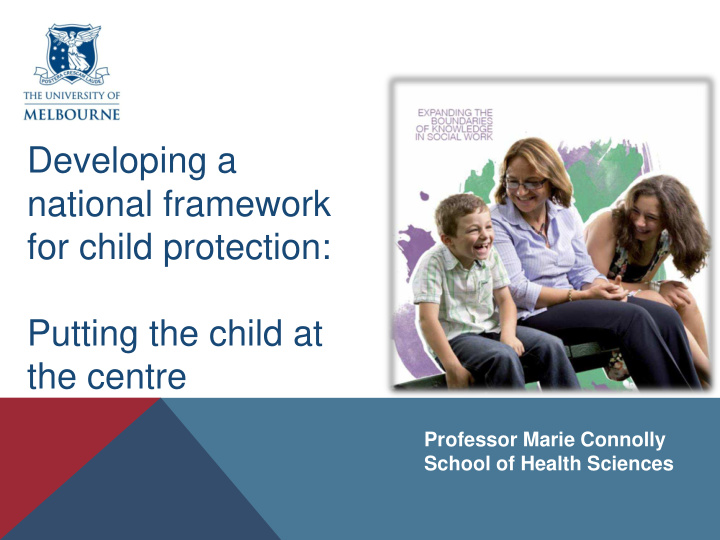



Developing a national framework for child protection: Putting the child at the centre Professor Marie Connolly School of Health Sciences
A principled approach to child protection Within a systemic frame… o Rights are upheld and participation is promoted o Responsibility for child wellbeing is broadly interpreted and responses extend across formal and informal systems o Policies and interventions are supported by a strong evidence base
Soci cieta tal Opportunities for Multi-layered cont ntexts xts mobilizing community systems aimed at Service vice and neighbourhood primary prevention cont ntexts xts action to support the as well as more interests of children – targeted secondary Commun mmunity ty engaging with media, and tertiary business and prevention (Barlow & Calam community leaders Fami mily ly 2011; Jack 2010; Munro 2009) Child ld Less formal More formal ... Nested, interacting systems
Increasingly systemic frames support a mix of service levels within the service context... o Agencies working toward tertiary what is best for the child Protection of children’s o rights to: participation; secondary care; protection; information; privacy o Respecting the rights of families primary o Respect for language, religion and culture
Soci cieta tal Opportunities for Multi-layered cont ntexts xts mobilizing community systems aimed at Service vice and neighbourhood primary prevention cont ntexts xts action to support the as well as more interests of children – targeted secondary Commun mmunity ty engaging with media, and tertiary business and prevention (Barlow & Calam community leaders Fami mily ly 2011; Jack 2010; Munro 2009) Child ld Less formal More formal Opportunities for mobilizing resilience and strength across systems
Taking a good look... Understanding how being in the world impacts on a child’s resilience and vulnerability… As part of a multi-layered response, a preventative public health approach helps us to understand the scope of the issues confronting us, helps to identify risk indicators at the individual, family and community levels, and supports prevention strategies that are informed by evidence. (Jack, 2010) Societal Contexts
Societal Contexts... A public health model aims to shift norms associated with child maltreatment so that harsh parenting or abusive or neglectful treatment of children is less common across the whole population. The prohibiting of physical punishment of children is an example of a public health response. Creating flexible and responsive database systems provides greater opportunity to develop prevention strategies that are informed by evidence.
Are our child protection systems child-centred? Through a child’s lens do they make things better or worse? Changing lenses
Child-centred national frameworks – How might they influence service contexts? o Developing a coherent vision with child-centred leadership messages and articulating these consistently o Safeguarding children through the development of knowledge-informed frameworks o Fostering child and family-focused organizational responses o Creating the space for child and family practice Service contexts:
Child-centred leadership... o Developing an organizational culture of child- centredness o Creating a coherent vision with children at the centre o Engaging staff as advocates for children child-centred values focusing on outcomes leadership messages are consistent over time Service contexts
Safeguarding children through the development of knowledge-informed frameworks... Service contexts
Safeguarding children through the development of knowledge-informed frameworks... Family engagement strategies... Strategies that harness formal and informal networks in a common aim: to retain the child within the family, or restore the child to family. “Ethically, family engagement is a way to uphold both child and family rights” (Pennell et al 2011) Service contexts
Fostering child and family-focused organizational responses o One-size-fits-all responses are not child- centred responses. o Service pathways based on need provide more nuanced responses o Differential responses are designed to provide alternatives to statutory responses based on need. Service contexts
Creating a space for child and family practice Finding the balance between procedural guidance and professional judgement is complex. Over time, child protection systems have become increasingly proceduralized in an effort to ensure that communities are protected and that workers know exactly what to do and when to do it. Rather than improving practice, however, a more heavily proceduralized environment tends to work against the honing of strong professionally reflective judgement-making. It also takes professional time away from direct practice. Service context
Reducing Prescription... When organizations are in crisis mode, there is a danger that they will develop or re-write operational policies urgently, defensively and with an emphasis on prescriptive control. Systems need to find ways of reducing prescription and creating space for child and family practice. Service context
Creating a space for child and family practice... Risk assessment processes and tools often reflect an era of ‘risk saturation’. Some tools and risk assessment processes can reinforce more adversarial family/worker dynamics. Service contexts
Engaging with children and families... Using tools that engage and are easily understood... Service contexts
Child and family-responsive reforms need to be... o Knowledge-based, incorporating what we know influences good outcomes for children o Ethically-informed supporting strong engagement with families and reinforcing longer term safety and security for children o Discriminating well the needs of the children and families coming to statutory notice o Creating responsive regulatory frameworks where services work collaboratively in response to need o Ambitious for children coming to statutory attention o Courageous in ways that promotes children’s interests Service contexts: Reforming child protection
Soci cieta tal Opportunities for Multi-layered cont ntexts xts mobilizing community systems aimed at Service vice and neighbourhood primary prevention cont ntexts xts action to support the as well as more interests of children – targeted secondary Commun mmunity ty engaging with media, and tertiary business and prevention (Barlow & Calam community leaders Fami mily ly 2011; Jack 2010; Munro 2009) Child ld Less formal More formal Mobilizing opportunities to harness strengths across systems
It might require a change of lens...
But if we do take the time to change lenses, we’ll be in the business of finding solutions, supporting good outcomes, changing lives…
Recommend
More recommend